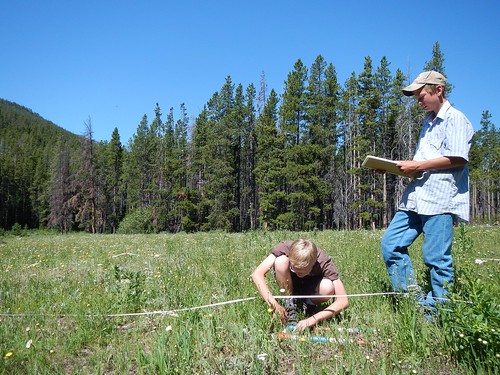
In an age where technology tends to focus the attention of youth indoors, getting kids outdoors and interested in natural resource careers is even more vital today.
Since 1998, an innovative U.S. Forest Service seven-week summer program in central Montana has been achieving that goal by immersing high school students in forest management. They gather data and present findings to Forest Service officials and other representatives in their local communities.
Students involved with the Youth Forest Monitoring Program spend the summer monitoring the health of the national forests at a variety of different locations in the area, but one of the high points is their three-day trip into the Scapegoat Wilderness on the Helena National Forest northwest of Lincoln, Mont. Though the area isn’t far from where many of these students have grown up, the trip gives them the opportunity to experience a protected area many had never visited before. Earlier this year, 13 students along with four field instructors were there to gather data on recreation impacts, water quality and document the spread of invasive weeds.
“This is a highlight for the students,” says Liz Burke, the Helena National Forest program manager of the Youth Forest Monitoring Program. “It’s a three-day, two-night backpack trip where we hike in seven miles to Webb Lake for monitoring recreation impacts, and also for perfecting their monitoring skills.”
In addition to measuring stream and soil health near Webb Lake, the students also visited nearby Heart Lake to look for amphibians. The number of amphibians and the diversity of species they find can help Forest Service officials determine water quality.

Tom Pederson, a field instructor and science teacher at Capital High School in Helena, Mont., says the types of insects, fish and other species that live in the water are indicators of what students are looking for in healthy streams.
“The quality of the water is based on life in the water, not drinking water, so you’re looking at chemistry, macro-invertebrates and physical features of the stream,” said Pederson.
After gathering the data, the students then compare their information with data students have gathered in past years and later present their findings to Forest Service officials, elected officials and the public.
“It’s a great opportunity, because it always seems like they take our recommendations and really look at what we’re talking about, and it makes you feel important,” said Kaitlin Martin, a senior at Helena High School who is in her third year with the program.
The Youth Forest Monitoring Program is open to high school students in Lincoln, Helena and Deer Lodge and work on projects on both the Helena and Beaverhead-Deer lodge National Forests. Students work with the Forest Service to find areas where their monitoring data can help forest managers determine the impacts of natural events such as fires, floods or rock slides as well as the impacts or effectiveness of management actions.
Amber Kamps, District Ranger for the Lincoln Ranger District on the Helena National Forest, says monitoring creates a feedback loop following the completion of a project on the forest.
“Often times you can be working so hard at implementing all of your projects, but then you don’t get that feedback of how well those projects are being implemented, how well those treatments are actually being applied, and then what’s the response,” said Kamps. “Are we getting the response that we need? And if we aren’t getting the response we need, then maybe we need to choose something a little bit different.”
The program has been incredibly successful through the years by introducing kids in high school to natural resource careers. Burke keeps in touch with alumni of the program through annual surveys, and has found that more than 60 percent of the students who have taken the program ultimately seek out a career in natural resources.
At the end of the seven-week program, each of the students receives a stipend. Youth Forest Monitoring Program is supported by a partnership with the Helena National Forest, Montana Discovery Foundation, Helena College of Technology, and generous support from local counties.
Additional photos from the Youth Forest Monitoring Program’s work in the Scapegoat Wilderness are available on the U.S. Forest Service Northern Region Flickr page.

